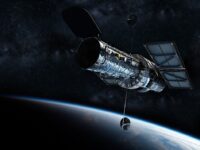Humans produce a lot of trash. The Great Pacific Garbage Patch, for example, has accumulated plastic and other kinds of waste from all over the world’s oceans. While the problem of polluting the seas is fairly well known, another territory is also feeling the effects of human interference: space. It is estimated that there are over 27,000 large pieces of debris floating close to the Earth, posing a threat to functioning satellites and government spacecraft. It can not be solved as simply as the problems that exist on Earth though, and the debris, both small and large, pose a deadly hazard.
According to NASA, debris in the Earth’s low orbit can reach speeds of approximately 15,700 mph, making space travel at any capacity a large risk. In 2019, there was an incident in which India blew up a dead satellite and created thousands of large pieces of debris and shrapnel that threatened the International Space Station. So what exactly is being done to combat these issues and prevent the waste problem that is happening on Earth?
It is estimated that there are over 27,000 large pieces of debris floating close to the Earth, posing a threat to functioning satellites and government spacecraft.
Right now, scientists are implementing new technologies to help limit the amount of space junk. The recently-developed End-of-Life Services by Astroscale is a spacecraft addition that attaches to compatible docking plates and pushes dead satellites towards the Earth’s atmosphere to burn up. The only issue with this new technology is that it can only be attached to satellites before they are launched; it does not solve the current problem. Thankfully, scientists thought of the simplest way to solve the problem of debris, through the use of magnets. The only blatant complication is that space debris, with the majority consisting of aluminum, contains little magnetic material. However, in an innovative new study, Lan N. Pham and collaborators discovered that the physics concept of magnetic induction may hold the key. In this phenomenon, a strong enough magnetic field can turn any conductive material, like aluminum, into a magnet by inducing electrical current loops through the metal from proximity. These loops, or eddy currents, can then generate a temporary magnetic field that opposes the original, thereby decreasing the speed of the object. Referred to as a “non-contact manipulation method,” the induction acts similarly to a science-fiction movie’s depiction of a UFO tractor beam. While this 3D manipulation is normally limited to a single direction, the fields of the electromagnets can be purposefully arranged on any axis. This breakthrough has major implications: the speed and orientation of debris can be controlled, limiting the hazards of these objects. On top of that, this magnetic manipulation technology promises to safely disintegrate debris in the Earth’s atmosphere. However, this breakthrough is not without its problems. Scientists cannot easily test the use of electromagnets in this capacity without simulating the effects of space. Because weight is certainly an aspect of life on Earth, it makes the minimal force of attraction much more difficult to accurately measure without being in orbit. So until that is tested further and studied, this method of electromagnetic inductions is only theoretical — but scientifically likely very possible. Additionally, the strength and distance of the magnetic attraction are still factors that scientists are trying to solve. The study found that as of right now, the induction of non-magnetic objects currently can only be done within the minimal range of 5 to 10 centimeters before losing strength. The functional hope, however, is that the magnets will be used from large distances without having to be in any danger of any harmful collision.
The physics concept of magnetic induction may hold the key.
So, while this new type of technology is likely plausible, more testing is needed to ensure that it can be applied without risk and with minimal error. When completed, it could pave the way for a new type of thinking and design into how human waste is properly disposed of and ultimately removed before causing more harm to the environment and ourselves.
Sources: Nature (2021). DOI: 10.1038/s41586-021-03966-6






